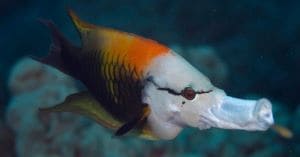Home › Sea Life › Marine Creatures › Vertebrates › Wrasses › Thicklip Wrasse
Interesting Facts about Sling-Jaw Wrasse
[Phylum: Chordata] [Class: Actinopterygii (bony-fish)] [Order: Labriformes] [Family: Labridae]
There are more than 600 different wrasses, but one particular wrasse species boasts jaw protrusion to the extreme (more than half of the length of its head).
This guide contains facts and information about the slingjaw wrasse fish and how they use their extra long jaw like a telescopic tube to feed.
Long-Jawed Wrasse Habitat and Distribution
Most scuba divers and snorkelers call it the sling-jaw wrasse (scientific name Epibulus insidiator). But, other names for these wrasses are:
- Long-jawed wrasse
- Maori wrasse (the humphead species)
- Telescope fish
- Thicklip wrasse
Nonetheless, this fish species belongs with the genus Epibulus and the family Labridae.
The slingjaw wrasse is not an endangered species and they are widespread in the tropical areas of the Indo-Pacific region.
In general, they have a yellow or brown body - with several standout variants. It is one of the small wrasses. The slingjaw fish measures around fourteen (14) inches long (35 centimetres) and weighs about 2.03 lb (921 grams).
But, during a normal lifespan, many of the species change their body shape and colouring as they develop from juvenile to adults. They are always active in the daylight, but they are one of the first to 'hit the snooze button' when it gets dark.
If you're a diver or snorkeler you will find them one of the easy vertebrate fish species to spot. In fact, they thrive best around coral reef formations, usually seeking shelter behind the branches and inside rock crevices.
Even so, it's not uncommon to find them living near lagoons and on steep reef slopes down at forty (40) metres.
Slingjaw Wrasse Unique Feeding Mechanism
Having extendable jaws means the method they use to hunt food works like a vacuum cleaner. The wrasse is slow in stalking its prey. Then, it shoots out its protrusible jaws to suck in the meal.
In fact, their jaws can extend forward to something close to half of their body size. As a result, even the juveniles can feed on small crustaceans rich in nutrients (e.g. sea shrimps). Then, they use pharyngeal jaws to grind down any thick shells
What Do Slingjaw Wrasse Eat?
Most of the wrasse fish species use their extended teeth to graze on the bottom of the seabed. Hence, the main diet for these carnivores will include a large variety of:
 Algae
Algae- Crabs
- Shrimps
- Small fishes
- Saltwater sea snails
- Worms and insects
Note: Another section contains more facts and information about the parrot fish species, a common sighting that is closely related to wrasses.
Fun Facts about Slingjaw Wrasses
- Slingjaw wrasses are hermaphrodites. So, as they transition to males later in life, females can change colour from dull brown or bright yellow to a fish with a white head and orange back.
- You will find slingjaw wrasse in Australia, Hawaii, Indo-pacific Regions, Japan, Red Sea, and South Africa.
- Generally, Epibulus insidiator are asocial, solitary creatures by nature and they tend to avoid any kind of social interaction.
- In fact, yellow females may change colour to dark brown when they get too little social interaction.
- Wrasses have protractile teeth, which means they come forward as part of the jaw. The fish can project the jaws and teeth to suck in their food.
- The estimated lifespan of the slingjaw wrasse is about five (5) years, based on similar species that live in the Indo Pacific region.
Related Information and Help Guides
- Asian Sheepshead Wrasse Facts and Information
- Slippery Dick Wrasse Facts and Information with Pictures
- Wrasses Facts and Species Information with Video
- Flashlight Fish Facts and Species Information with Pictures
- List of Marine Vertebrates Examples for Beginners
Note: The short video [1:24 seconds] has some additional facts about the unique fish with extendable jaws called the slingjaw wrasse (Epibulus insidiator).